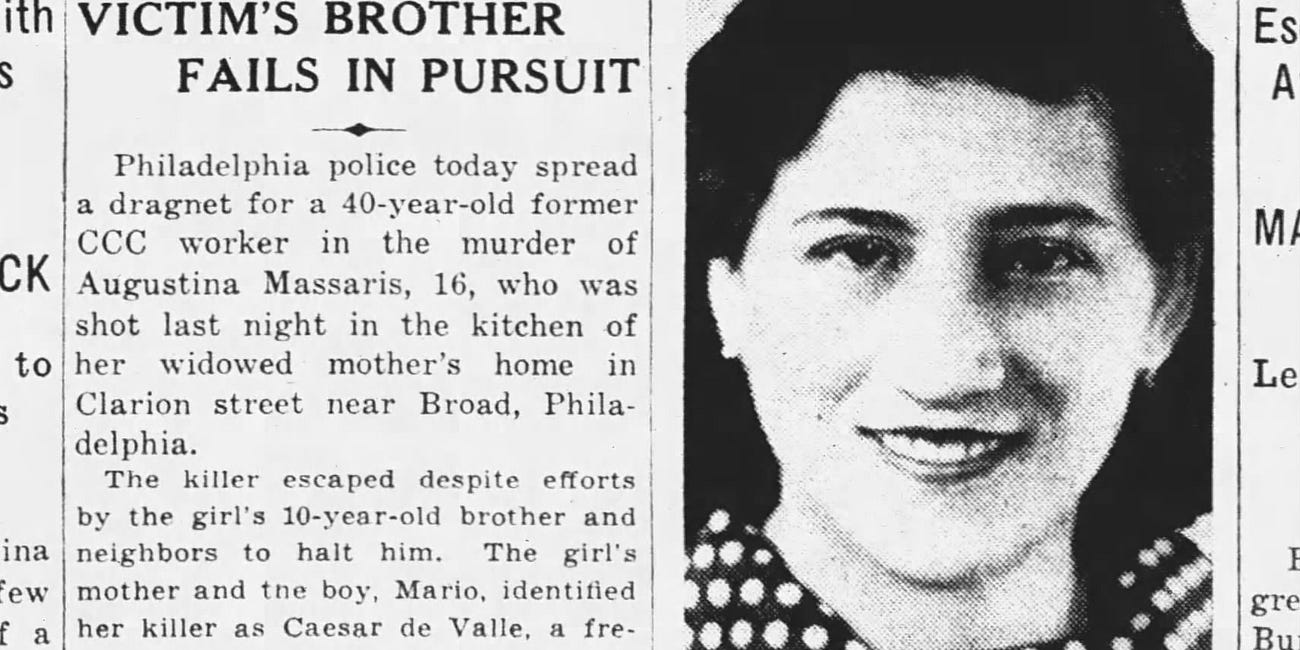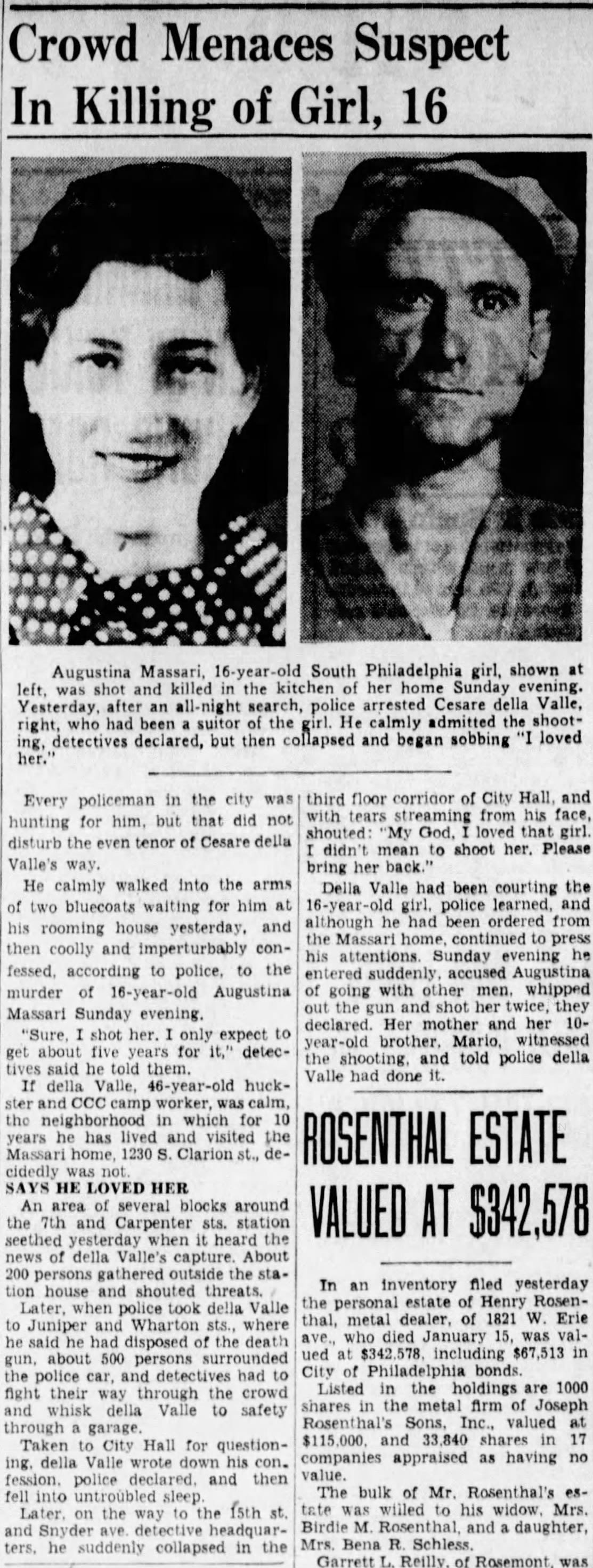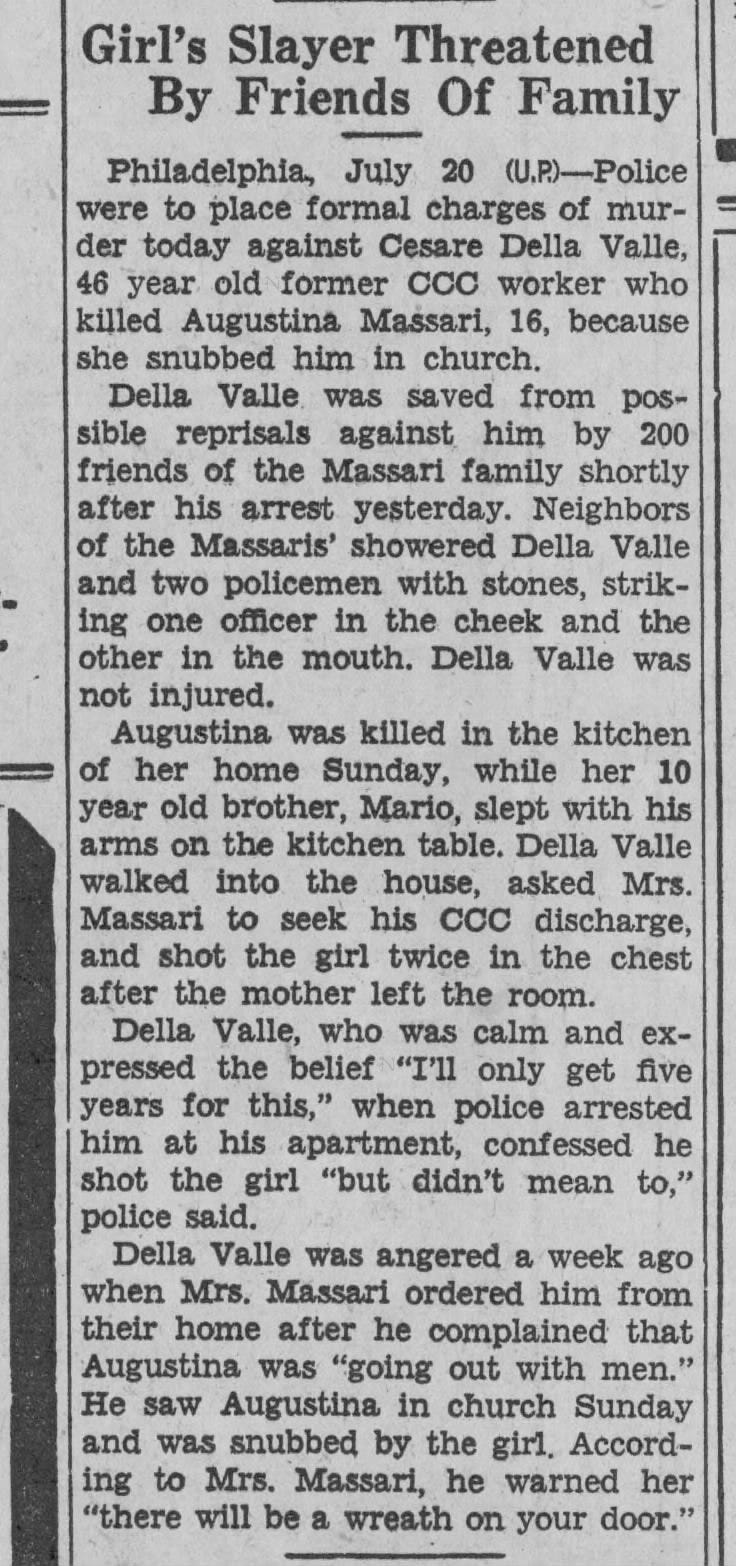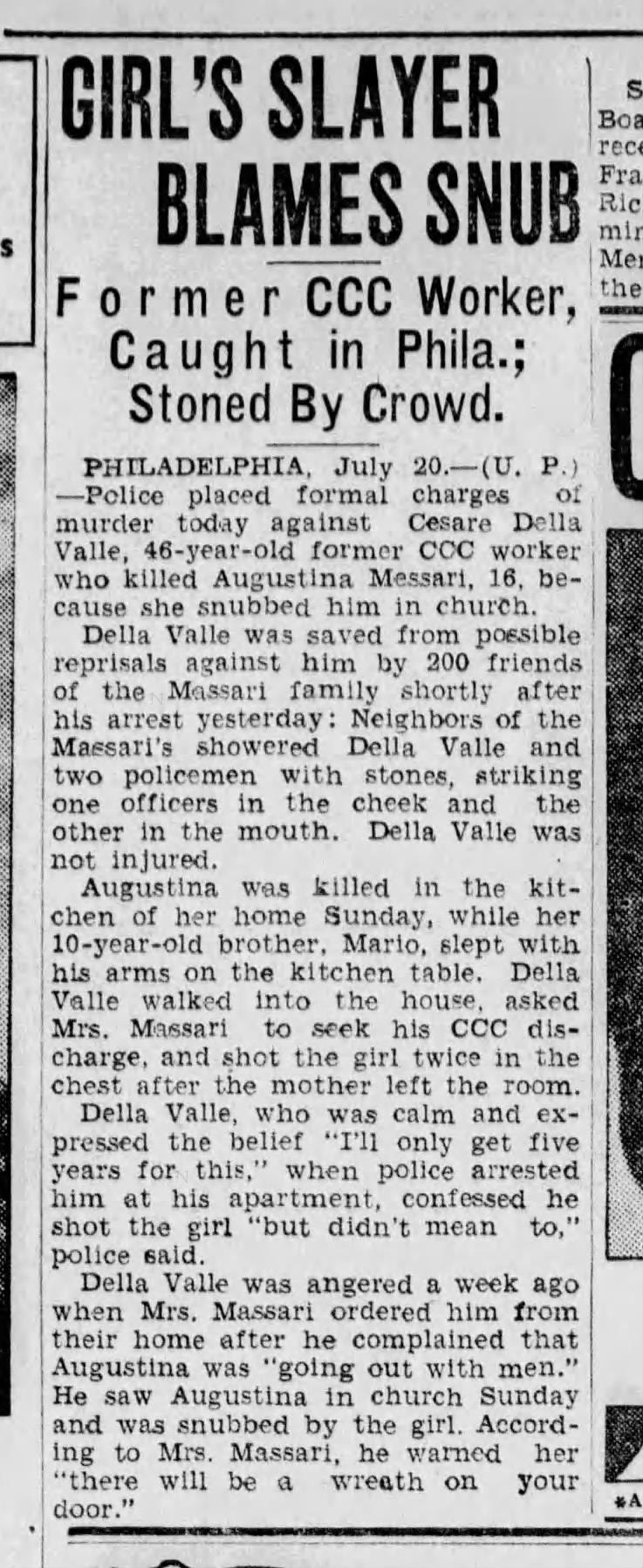Revisiting A 90-Year-Old Murder: Uncovering A Death That Changed My Family's History, Part 2
PT. 2 How family lore about the murder of my Great-aunt went from a vague story to major Philadelphia news
Where we last left things, a few months ago, I laid out the prologue and first day regarding my great-aunt Augustina’s murder. The key points on how it remained a vague family story never spoken about in detail, and how I ultimately came to learn about the event in its entirety.
Eating an Elephant
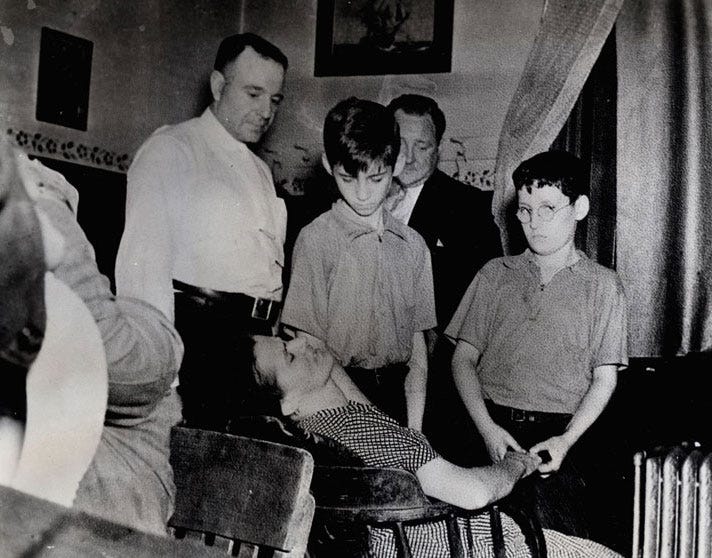
Without rehashing too much, for any new readers, you can catch up in the previous Substack pieces that have led us to this point.
First, in:
Then, the launching point of the series below:
Revisiting A 90-Year-Old Murder: Uncovering A Death That Changed My Family's History
Prologue: Laying the Groundwork
In Part 1, I presented the first day of coverage for Augustina’s murder, beginning on July 19th, 1937, the day after her murder.
When I first started researching this event and drafting this series, I also spent some time working with a podcast on the topic. Long story short, they are a podcast that focuses on Italian American stories, we connected, they were interested in the topic, and ran with it. Now, they have since completed their episode a few months ago, and I had planned to finish this series in December 2024, around the same time they completed their episode, but fate has had other plans.
I will be eventually plugging their episode, but I'm in a conundrum. Do I plug their episode before finishing my story and evolution through this process? Or do I wait and post their episode in my conclusion piece?
I'm leaning toward releasing their episode on the last part of this series, and if you really need to know what happens, you're more than welcome to Google it.
For those who like spoilers.
Unfortunately, I have gotten a full palm slap of life in a ‘Story of Job-lite’ series of trials since December, where writing this has become less of a priority next to keeping everything else on my plate and responsibilities crashing to the ground.
And, while I'm late doing this, I'd like to credit two readers, Olivier and Cathy.
After reading Part 1, they made the following contributions.
Cathy:
“My first thought about the "crepe at your door" comment was a harkening back to Victorian times as described at this site:
https://tinkercottagemuseum.wordpress.com/2014/09/30/the-etiquette-of-mourning/
Too far in the past to apply?”
Olivier:
“I am writing to tell you that you are almost certainly off-base with your crêpe = crepa = cracks tortured reading. Crêpe is a textile, too; in those days dresses of black crêpe were traditionally worn for mourning and wreathes of the same hung at the door. That fits the story perfectly.”
This was also the explanation found by the podcast, and I am very thankful for them telling my family’s story in such a well-done and thoughtful episode.
I greatly appreciate Cathy and Olivier’s feedback, and it makes more sense than the round hole I was trying to square.
So, eyes forward, it’s time to tackle this piece by piece, bite by bite, and build the fullest picture I can about the events that occurred in 1937 as I can, without any living witnesses and a minor second-hand account.
We hit day two of coverage, July 20th.
July 20, 1937
Thoughts:
One of the original versions of this story, vaguely understood by my father and aunt, was that whoever had killed Augustina was a rejected suitor of some level. But, there was a back and forth between whether the rejected man was for Felicia, my great-grandmother, or Augustina because, again, the story was mainly conceptual and rarely spoken of. Was the gunshot meant for one and not the other? Was the murderer trying to kill Felicia's daughter because she rejected him? Was it even potentially meant for my grandfather or granduncle, or had some negative interactions with the man? There was a lot of speculation before these articles were found. Finding this concrete information that the rejected man was angry at Augustina and was not even someone her age, but 46, and she was 16, brings a whole new layer to this story. I understand this article was from another era, but even for the period, it just seems so odd. Icky? Even out of place in the verbiage. To even call him a suitor downplays what he really was: a stalker and pedophile.
The murderer first declaring his action calmly, then breaking down in an emotional mess, is one of many instances that struck me that he was most likely a mentally unstable individual with some personality disorder or significant imbalance.
What really strikes me is the crowd size, counted by the paper as 200, outside the station issuing threats. It's striking for several reasons. One, a family story never spoken about, seemed small and insignificant. But it wasn't. It impacted this entire neighborhood of Italian immigrants and showed how tight-knit the community was. Then, when really hammering down how tight-knit this community was, in all likelihood, I have to think this might not have been a mob for the sake of being a mob. I'd have to think a large majority of this mass knew Augustina, or at least my family, in some form or fashion, and her murder had an impact. I'd argue had a non-Italian committed the murder, they might have just been pissed because it was committed by an outsider. But this was one of their own within the community. The murderer might have also had a negative reputation, further fueling the rage. There are a lot of possibilities that stem from this community's reaction. Regardless, seeing this crowd size completely changes the isolated perspective I've had my entire life regarding this story.
From 200 to 500? I want to question the numbers, but I'm also hesitant to do so at the same time. Life in these tiny, immigrant communities was their own ecosystems that didn't have televisions, internet, radio, or all the modern convenience bubbles we huddle. I don't think it would be unrealistic for 500 people to gather with a legitimate connection to these people. However, I also can't discount that it did grow throughout the night and did turn into a mob that was simply angry that a girl was murdered and did not have direct or even indirect relations with my family. Newspapers during this period could embellish information, so I am hesitant to fully buy into a crowd of 500.
Again, the murderer confesses to killing Augustina and then falls into an unbothered sleep only to return to pleading he wishes he hadn't killed her. This does not sound like he is mentally stable, considering he is switching back and forth so quickly emotionally.
The way this article called the murderer a suitor and then that he was 'courting' Augustina, maybe I just don't understand the period as well as I thought, but 46 and 16, I would feel even then it would come across as abnormal. He is not mentioned as a widower or family, so he was probably single for life, and there's no excuse of royalty or marriage for political reasons. You don't court a 16-year-old at 46 if you are normal or stable.
It sounds like the neighborhood, from the moment the murderer left the scene after murdering Augustina, was hunting him down.
The murderer living in the home adds yet another element to this whole situation. With my great-grandfather dead at this point, an immigrant Italian woman with near non-existent English in her 60s, let alone her 30s at this time, with three children to feed during the Great Depression and no social net, Felecia didn't exactly have many, if any, economic opportunities to keep a roof over their heads. My father says she was a highly religious, almost nun-like Catholic woman. I have to wonder if even renting a room to a man she wasn't married to and Catholic guilt after the fact of her daughter's killer being someone she let in the home, what kind of mental impact that might have had on Felecia. I know it mostly likely did because growing up and living with her, my aunts were frequently called butanna, or butane, slang for the more traditional puttana, translated as whore, because of how they dressed or for wearing makeup. Essentially, normal young girl activities regarding appearance. I don't need to be a psychologist to believe her daughter being killed over the attention of an older man and his claim that he took her daughter's life because of his jealousy of Augustina's popularity with boys, real or imagined; the fears and pain produced from that event were infused in those words every time she stated them.
Again, this 46-year-old man 'loved' Augustina, and he was driven mad because she ran around with other boys is insane. It hits several red flags for me.
1: This individual is clearly unstable. Were there even any 'boys' to begin with? I cannot stress this enough; the age gap and his mental stability make me question if Augustina was even around boys and if it was all imagined.
2: When did this 'love' begin? Six years in the home means he moved in when Augustina was 10…again, this man is demented. I don't even want to imagine the potential hazards this man created in this home.
Please imagine a 10-year-old with a butcher knife chasing a grown man after watching their sibling being murdered. This sentence alone should be powerful. Just letting those words sink in and settle.
Seeing snubbed again downplays the massive age difference.
Another report of the 200-person mob. Was the writer pulling from the same source, or were they on-site?
My grandfather asleep at the table was a key detail that even my father and aunt knew. Seeing it in a paper drives home how real this all was and beyond the 'bedtime' story element of family lore.
Again, there's that split personality of the murderers' emotions. I genuinely believe he was a mentally unstable human being
"There will be a wreath on your door." Can I give another special shout-out to the readers, Cathy and Olivier, for nailing this?
Another example of the quote, “wreath on your door,” makes me wonder if it was the original wording or wreath was a plug-in for crepe.
Conclusions
One of my biggest takeaways after the two days of coverage for Augustina by the newspapers is that I genuinely, in the most unsarcastic way possible, would have to assess that the murderer was mentally unwell and not minimally.
He was a 46-year-old unmarried man who was in 'love' with a 16-year-old girl, and he had documented episodes of manic and emotional swings beyond this event.
I get in the year 2025; being a single 46-year-old man isn't out of place. However, in the 1930s, economically and socially, it was very different in context, especially when it does not seem like he was ever married. It's never mentioned, just his work history. The murderer has a criminal record of violence, at least one documented example, no mention of relatives, and becomes emotionally explosive over a 16-year-old girl.
Unfortunately, it is disturbing to expand on that thought, but when did his fixation with Augustina begin? He entered the home when she was 10. Not that I want to go down other dark roads, but from a purely historical analysis, I would have to assume the children's attitude towards this man was created by some history within the house, whatever it might be. And, who else in the home was affected by him and never spoke about it? Was it just Augustina, or were there others, maybe even outside of the house within the neighborhood? Perhaps he truly was just an unstable authority figure they felt was trying to replace their father, who made unwelcome advances toward Augustina, and that was it.
I find it hard to believe it spawned out of nowhere, and this was an isolated circumstance. This man seems volatile, and I am sure there are plenty of events lost to time, which further establishes how unwell he was.
Another significant and much less dark point is how much this impacted this Italian-American community.
It's hard for anyone outside my immediate family to understand the impact of discovering the details of this event. The story was not necessarily taboo, but a vague coupling of events that seemed small and intimate, almost insignificant outside my grandfather and my great-uncle Joe. An event that was confined to the 'Massari's.''
But it wasn't.
Whether it was 500, 200, or even 50 people, it wasn't something that only affected the Massaris; it affected an entire community of people, so much so that they were actively searching for Augustina's killer nonstop. This was and is not just our story; it's this community of Italian-Americans in South Philly, all of whom I will never know the names of.
People who knew Augustina, Mario, Joseph, and Felecia intimately, in passing, casually, indirectly, and directly. This was part of their lives and impacted them directly.
It was a lived event for my grandfather, my great-uncle, and my great-grandmother, to my father and aunt, secondary. And for me, I'm far from the ripples.
On the outskirts of generations from Augustina's murder, it was a personal story and event in my grandfather's life, but discovering how impactful it was made me feel small. Augustina belonged to this community; she was a part of them, and they lost her. This wasn't inconsequential, but a devastating loss for more people than I ever imagined and people I will never know.
I find it heartbreaking and heartwarming to know it is much larger than we, the Massaris, those children and grandchildren of Joseph and Mario, could have known.
Augustina's murder was a real tragedy to those around her, something that enraged an entire community to seek vengeance and grew to a sizable mob, whatever the real number. While the trade-off doesn't compensate for the life taken, I think there is something poetic in discovering all of this. What we thought was tiny and reserved within our family bubble it turns out her death affected an untold number of lives.
Look out for Part 3 soon.



